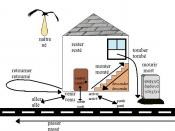Chapter 3
GRAMMAR BRIEFING 1: Simple Present versus Present Progressive
The simple present and the present progressive both describe present time. However, they describe present time in different ways.
FUNCTION Simple Present versus Present Progressive
ï® The simple present tense describes habits, routines, and things that are generally or always true.
They usually get up at 7:30. (routine) Stress affects our personality. (generally true)
Adverbs of frequency (see Chapter 1) often occur with the simple present tense. These time expressions also often occur with the simple present tense: every day, in the afternoon, at night, most of the time, on Saturdays.
ï® The present progressive tense describes temporary actions happening at the moment of speaking or over a longer period of time in the present.
Right now, he's concentrating. We are working slowly these days.
(moment of speaking) (over a longer period of time)
The following time expressions often occur with the present progressive: these days, (right) now, today, tonight, this week, this semester, this month, this year.
GRAMMAR BRIEFING 2: Verbs with Stative Meaning
Verbs with Stative Meaning
Some verbs have stative (not active) meanings.
These verbs do not usually occur in the progressive.
FORM AND FUNCTION Verbs with Stative Meaning
ï® Verbs with stative meaning describe states, not actions.
ï® Some common verbs with stative meaning are:
Ideas Attitudes Emotions Possessions Senses Descriptions
forget need hate have hear be
know want like owe see cost
remember love own smell look
think sound seem
understand taste weigh
ï® These verbs do not usually occur in the progressive, even when they are describing something happening right now.
You seem nervous at the moment. NOT: You are seeming nervous at the moment.
ï® Some of the verbs above have both a stative meaning and an active meaning. When they have...


